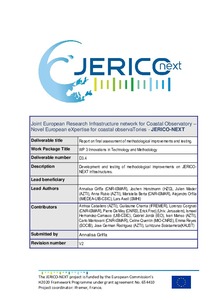| dc.contributor.author | Griffa, Annalisa | |
| dc.contributor.author | Horstmann, Jochen | |
| dc.contributor.author | Mader, Julien | |
| dc.contributor.author | Rubio, Anna | |
| dc.contributor.author | Berta, Maristella | |
| dc.contributor.author | Orfila, Alejandro | |
| dc.contributor.author | Axell, Lars | |
| dc.date.accessioned | 2020-11-17T16:15:46Z | |
| dc.date.available | 2020-11-17T16:15:46Z | |
| dc.date.issued | 2019 | |
| dc.identifier.citation | Griffa, A.; Horstmann, J. and Mader, J. et al (2019) Report on final assessment of methodological improvements and testing. JERICO-NEXT WP3 Innovations in Technology and Methodology, Deliverable D3.4, Version 2. Brest, France, IFREMER, 56pp. (JERICO-NEXT-WP3-D3.4-180719-V2). DOI: http://dx.doi.org/10.25607/OBP-948 | en_US |
| dc.identifier.uri | http://hdl.handle.net/11329/1445 | |
| dc.identifier.uri | http://dx.doi.org/10.25607/OBP-948 | |
| dc.description.abstract | Deliverable D3.4 is the second and final deliverable of Task 3.2, where a final assessment and testing of all the new developed methodologies related to HF radar data is provided. An impressive suite of new tools is presented, and their impact on the use of HF radars is discussed. HF radars are today a vital and growing part of the observing system in Europe, and Task 3,2, have greatly contributed to this growth through methodological development. The work has been performed in synergy with other WPs, in particular WP4 for testing in specific areas, and WP5 for the elaboration of interoperability standards. Scientific collaborations have included a number of international scientists and institutions also outside the original JERICO-NEXT consortium, Testing has been carried out using data from several installations in various European seas and oceans, including the German Bight, the Bay of Biscay, the West Med, the Adriatic Sea and the Swedish coasts.The developments focus on the following three main aspects, mirroring the three subtasks in Task 3.2: 1) scientific basis for quality control and interoperability standards; 2) methods to optimize installation planning; 3) methods for advanced analyses to be used in practical applications.1.The quality of current retrievals has been investigated, and methods to improve their QC have been developed and tested. A focused scientific investigation has been performed on how to quantify accuracy in the important and challenging case of high current sub-grid variability. The approach, tested in the German Bight, provides general methodological indications that can be applied to different situations. Also, scientific support has been provided to the interoperability effort carried out in the framework of WP5. Improved recommendations for European QC have been investigated thanks to an international collaboration, providing the basis for the results in the WP5 deliverable D5.14.2. Methods to guide the design of HF radar networks have been completed. A cost benefit analysis is made available taking into account the geographical distribution of the requirements and the geographical capabilities of the existing and potential HF radar network. It allows the prioritization of potential new platforms considering their respective contribution into the overall impact of the HF Radar network. As a demonstrator, different scenarios have been assessed for the development of long-range HF Radar network in the Bay of Biscay and north-western Iberian Peninsula. An additional tool has been introduced for considering the variability of the ocean processes at the scale resolved by the targeted observing platform.
A number of new products have been implemented for the analyses of HF radar data and their use in practical applications. Methods for blending HF radar data with water column information from ADCP and glider data have been implemented and tested, providing guidance for important future applications toward the integration of different observing system components. Various gap filling methods have been tested and a new one implemented, in order to ensure smooth trajectory computations for transport applications. Innovative flow characterization methods for biological applications have been explored. They include Lagrangian methods to quantify flow transport and retention, and their impact on phytoplankton or larval transport and fishery management, as well as a new class of indexes of small scale divergence and vertical velocities with potential ecosystem impact. Finally, two different approaches to improve transport and flow forecasting using HF radar data have been assessed. | en_US |
| dc.language.iso | en | en_US |
| dc.publisher | IFREMER | en_US |
| dc.relation.ispartofseries | JERICO-NEXT-WP3-D3.4-180719-V2; | |
| dc.subject.other | HF Radar | en_US |
| dc.title | Report on final assessment of methodological improvements and testing. JERICO-NEXT WP3 Innovations in Technology and Methodology, Deliverable 3.4. Version 2. | en_US |
| dc.type | Report | en_US |
| dc.description.status | Published | en_US |
| dc.format.pages | 56pp. | en_US |
| dc.description.notes | Contributors: Ainhoa Caballero , Guillaume Charria , Lorenzo Corgnati , Pierre De Mey ,Erick Fredj , Ismael Hernandez-Carrasco ,Gabriel Jordà ,Ivan Manso , Carlo Mantovani , Celine Quentin, Emma Reyes,,Jose German Rodriguez , Lohitzune Solabarrieta | en_US |
| dc.description.refereed | Refereed | en_US |
| dc.publisher.place | Brest, France | en_US |
| dc.subject.instrumentType | Instrument Type Vocabulary::radar altimeters | en_US |
| dc.subject.dmProcesses | Data Management Practices::Data quality control | en_US |
| dc.description.currentstatus | Current | en_US |
| dc.description.sdg | 14.A | en_US |
| dc.description.maturitylevel | TRL 8 Actual system completed and "mission qualified" through test and demonstration in an operational environment (ground or space) | en_US |
| dc.description.bptype | Best Practice | en_US |
| dc.description.bptype | Manual (incl. handbook, guide, cookbook etc) | en_US |
| obps.contact.contactname | Patrick Farcy | |
| obps.contact.contactemail | patrick.farcy@ifremer.fr | |
| obps.resourceurl.publisher | https://www.jerico-ri.eu/download/jerico-next-deliverables/JERICO-NEXT_Deliverable_3.4_180719_final.pdf | en_US |
 Repository of community practices in Ocean Research, Applications and Data/Information Management
Repository of community practices in Ocean Research, Applications and Data/Information Management
